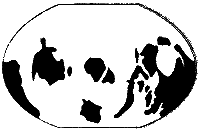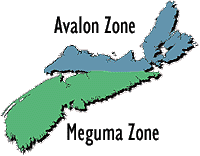    |
| Cambrian Period First Vertebrates (570-505 million years ago) |
 Global View - Where was Nova Scotia? Global View - Where was Nova Scotia?The large southern land
mass Gondwanaland consisted of what are now South America, Africa, Madagascar, India,
Australia and Antarctica. The northern continent Laurasia consisted of present day North
America, Greenland, Europe and most of Asia.
Rocks of Nova Scotia Three areas in the Avalon Zone have Cambrian rocks -- Cape Breton Island, Antigonish Highlands, Cobequid Highlands. Volcanoes were active in the area, spreading their debris over the land and shallow seas. The Meguma Zone differs from the Avalon Zone because the two areas were widely separated and in different environments. In the Cambrian Period, the Meguma Zone lay seaward of a large continental landmass, believed to have been North Africa. Large volumes of sediment were transported from the continental shelf of the landmass to the depositional area of the Meguma Group by turbidity flows. These deposits are represented by the thick, uniform sandstones of the Goldenville Formation and are overlain by slates of the Halifax Formation. More than two million cubic kilometres (480000 cubic miles) of sediment were deposited in the Meguma Zone.
Palaeoenvironment Fossils from the Cambrian Period are rare, indicating that the environment was cold and hostile. The land and shallow seas were inhabited by hardy brachiopods, trilobites and graptolites, which survived for millions of years after this time period. This was a very unsettled time, geologically, with plenty of volcanic activity. |
 Nova Scotia's Avalon Zone was part of a landmass called Avalonia (present
day northern Europe and Greenland), which became attached to the North American
continental landmass during the Ordovician Period. The Meguma Zone belonged to another
large landmass called Gondwanaland and lay offshore what is now northern Africa.
Nova Scotia's Avalon Zone was part of a landmass called Avalonia (present
day northern Europe and Greenland), which became attached to the North American
continental landmass during the Ordovician Period. The Meguma Zone belonged to another
large landmass called Gondwanaland and lay offshore what is now northern Africa.